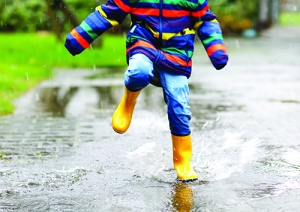By nature, children are curious about the weather. This post will focus on helping children learn about and study the weather while using a Weather Display, a resourceful tool found in the Starter Pack of our Lillio Learning for Preschool Classrooms curriculum kit. Making weather observations with children is a comprehensive process. First, they predict or forecast the weather, and then they test their predictions by making observations and exploring with their senses. Children also explore the concept of cause and effect when they engage with the weather.
Prediction and Forecasting: In order to make predictions about the weather, children must observe their surroundings. Children might recognize and describe certain features of the sky and climate to help make their guesses. Support them by asking questions such as: "What color are the clouds? What color is the sky? How does the temperature feel? Are the trees moving?"
Weather Observation: Our senses play an important part in science activities. For example, a sunny day, a cloudy day, and a foggy day look different from each other. How can children tell them apart? Through sight! Weather is also audible. Our ears help us hear the rain or the wind. The sense of touch helps children feel the texture and temperature of the snow (more adventurous children might further explore through taste). And last, we explore the weather through smell. If you pay close attention, you can smell the rain just as you can smell fresh cut grass in a field or the ocean breeze on a hot summer day at the beach.

Cause and Effect: It goes without saying that weather conditions have an effect on us and the environment around us. An example of this is that after a rainy day, there might be puddles to jump in or a beautiful and colorful rainbow to observe in the sky. Another effect that the weather produces is that it determines the way we dress. The weather can also influence children's moods. For example, on a rainy or cold day, some children may feel sad that they cannot play outside.
Getting Started with the Weather Display
The Weather Display is introduced in the front pages of the monthly curriculum guide for Lillio Learning for Preschool Classrooms. Here, you are reminded about where to locate the display in your kit, and the section titled "Start Your Day" provides guidance for engaging children in meaningful activities. Children will be prompted to observe and describe the weather and consider the best way to dress for the day's conditions. The display includes spots for placing pieces that correspond to the current day's weather, yesterday's weather, predicting tomorrow's weather, which season it is, how to dress, and determining the temperature feel.
Benefits of Using the Weather Display in Your Setting
Children are usually filled with a great curiosity for science, and what better way to engage them than by studying the weather and climate change as a basic introduction to scientific exploration. Use the Weather Display to help children develop a desire to learn about science and weather patterns. Extend their interest by briefly talking about and comparing the weather in your area with the weather in other places around the world.
Cues for Including Weather Observations in Your Daily Routine
- In your science or pretend play area, include props for children to role-play weather reporters or meteorologists. Post the display nearby so they can move the pieces accordingly.
- Promote science investigation by taking toys and tools, such as plastic magnifiers and binoculars, to outdoor activities. Invite children to update the display based on observations they made.
- Each morning, talk with children about the weather conditions as they arrive. Ask open-ended questions for them to share their thoughts freely. Invite them to observe how the weather changes throughout the day. Make adjustments to the Weather Display as needed.